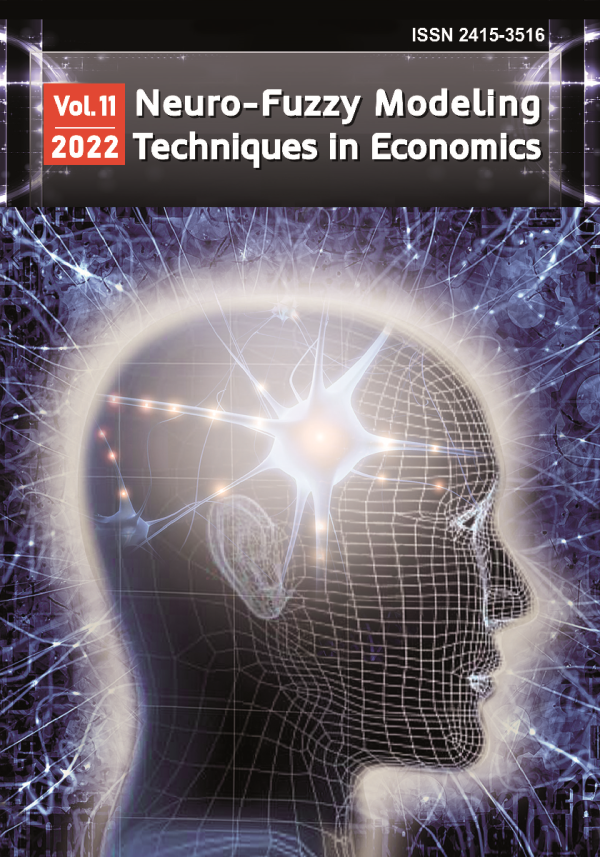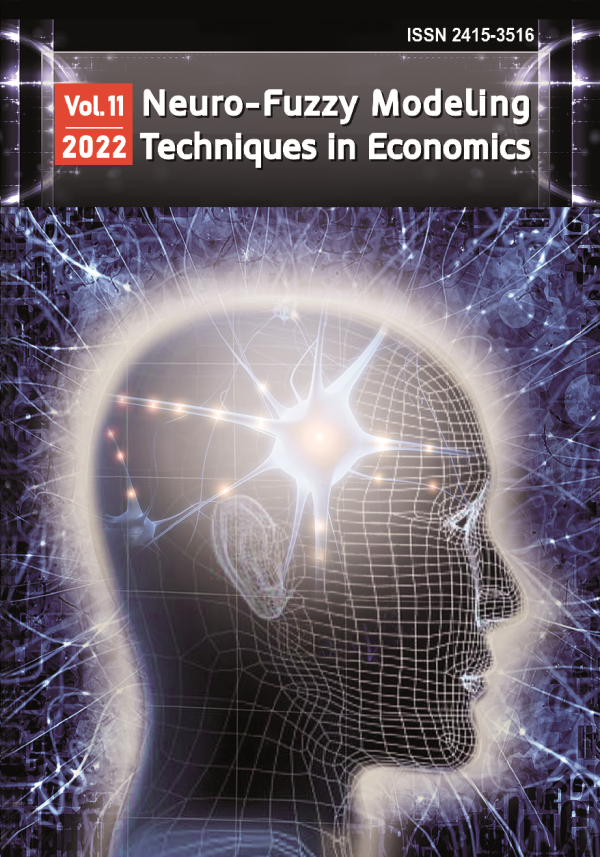
Neuro-Fuzzy Modeling Techniques in Economics
ISSN 2415-3516
Intellectual capital management of the business community based on the neuro-fuzzy hybrid system
DOI:
10.33111/nfmte.2022.025
Анотація:
Abstract: The modern economy needs to address the issue of assessing intellectual capital as the basis for the development of market relations. The search for ways to solve this problem is possible based on the use of soft methods. The aim of the article is to develop a structural model for managing the intellectual capital of the business community based on an appropriate neuro-fuzzy system. Developed on the basis of soft computing methods, an innovative model for estimating intellectual capital of the business community is able to process “non-rigorous”, incomplete or distorted input data, work with qualitative concepts, ambiguous and uncertain statements, perform operations with weak formalized economic parameters. The experimental results obtained made it possible to formulate the methods for evaluating the intellectual capital of business communities (or other similar economic systems) characterized by fuzzy relations between input and output parameters, considerable difficulties in formalizing the factors of influence, capability of using linguistic experts’ statements for building an information and analytical system, etc. The developed hybrid neuro-fuzzy system “Board” for evaluating intellectual capital of a business community enables to process both quantitative and qualitative input data, and was built up according to the criteria of digital economy transformation projects.
Ключові слова:
Key words: intellectual capital, management, modeling, fuzzy logic, business community
УДК:
UDC:
JEL: C45 M12 O34
To cite paper
In APA style
Kozlovskyi, S., Syniehub, P., Kozlovskyi, A., & Lavrov, R. (2022). Intellectual capital management of the business community based on the neuro-fuzzy hybrid system. Neuro-Fuzzy Modeling Techniques in Economics, 11, 25-47. http://doi.org/10.33111/nfmte.2022.025
In MON style
., Синєгуб П.С., ., Лавров Р.В. Intellectual capital management of the business community based on the neuro-fuzzy hybrid system. Нейро-нечіткі технології моделювання в економіці. 2022. № 11. С. 25-47. http://doi.org/10.33111/nfmte.2022.025 (дата звернення: 24.12.2025).
With transliteration
Kozlovskyi, S., Syniehub, P., Kozlovskyi, A., Lavrov, R. (2022) Intellectual capital management of the business community based on the neuro-fuzzy hybrid system. Neuro-Fuzzy Modeling Techniques in Economics, no. 11. pp. 25-47. http://doi.org/10.33111/nfmte.2022.025 (accessed 24 Dec 2025).
 # 11 / 2022
# 11 / 2022
Download Paper

933
Views
208
Downloads
1
Cited by
- LETA Capital, & Devar. (2021). State Of Phygital. https://global-uploads.webflow.com/6198cb076e036ab5a326fa84/623843d93006dc23e1b05264_STATE%20OF%20PHYGITAL%202021%20BY%20LETA%20AND%20DEVAR.pdf
- Bontis, N. (2001). Assessing knowledge assets: a review of the models used to measure Intellectual Capital. International Journal of Management Review, 3(1), 41–60. https://doi.org/10.1111/1468-2370.00053
- Galbraith, J. K. (1967). The New Industrial State. Houghton Mifflin.
- Sakaiya, Т. (1991). The Knowledge-Value Revolution, or a History of the Future. Kodansha International.
- Petty, R., & Guthrie, J. (2000). Intellectual capital literature review: Measurement, reporting and management. Journal of Intellectual Capital, 1(2), 155–176. https://doi.org/10.1108/14691930010348731
- Edvinsson, L., & Malone, М. (1997). Intellectual Capital: Realizing Your Company’s True Value by Finding Its Hidden Brainpower. Harper Business.
- Kozlovskyi, S., Baidala, V., Tkachuk, O., & Kozyrska, T. (2018). Managament of Sustainable Development of the Agrarian Sector of the Regions of Ukraine. Montenegrin Journal of Economics, 14(4), 175–190. https://doi.org/10.14254/1800-5845/2018.14-4.12
- Kasiewicz, S., Rogowski, W., & Kicińska, M. (2006). Kapitał intelektualny. Spojrzenie z perspektywy interesariuszy [Intellectual capital. View from the perspective of stakeholders]. Oficyna Ekonomiczna. [in Polish]
- Tobin, J. (1969). A general equilibrium approach to monetary theory. Journal of Money Credit and Banking, 1(1), 15–29. https://doi.org/10.2307/1991374
- Kaldor, N. C. (1966). Marginal Productivity and the Macro-Economic Theories of Distribution: Comment on Samuelson and Modigliani. The Review of Economic Studies, 33(4), 309–319. https://doi.org/10.2307/2974428
- Chen, S., & Dodd, J. L. (1997). Economic Value Added (EVATM): An Empirical Examination of a New Corporate Performance Measure. Journal of Managerial Issues, 9(3), 318–333. http://www.jstor.org/stable/40604150
- Finegan, P. T. (1989). Financial incentives resolve the shareholder-value puzzle. Corporate Cashflow, October, 27–32.
- Tully, S., & Hadjian, A. (1993). The real key to creating wealth. Fortune, 128(6), 38–50.
- Edvinsson, L., & Malone, M.S. (2001). Kapital intelektualny [Intellectual capital]. Wydawnictwo Naukowe PWN. [in Polish]
- Sveiby, K.-E., Annell, E., Axelsson, S., Emilsson, P.-M., Karlsson, H., Wangerud, C.J., & Vikström, S. (1990). The Invisible Balance Sheet. Affarsvarlden-Ledarskap.
- Buenechea‐Elberdin, M., Kianto, A., & Sáenz, J. (2017). Intellectual capital drivers of product and managerial innovation in high‐tech and low‐tech firms. R&D Management, 48(3), 290–307. https://doi.org/10.1111/radm.12271
- Carnegie, G. D., & Napier, C. J. (2017). The accounting, auditing & accountability journal community in its 30th year. Accounting, Auditing & Accountability Journal, 30(8), 1642–1676. https://doi.org/10.1108/AAAJ-12-2016-2804
- Malcolm, D. G., Roseboom, J. H., Clark, C. E., & Fazar, W. (1959). Application of a Technique for Research and Development Program Evaluation. Operations Research, 7(5), 646–669. https://doi.org/10.1287/opre.7.5.646
- Magee, J. F. (1964). Decision trees for decision making. Harvard Business Review, 42(4), 126-138. https://hbr.org/1964/07/decision-trees-for-decision-making
- Kelley, J. E., Walker, M. R., & Sayer, J. S. (1989). The origins of CPM: a personal history. PM Network, 3(2), 7–22. https://www.pmi.org/learning/library/origins-cpm-personal-history-3762
- Goldratt, E. M. (1997). Critical Chain. North River Press.
- Fleming, Q. W., & Koppelman, J. M. (2010). Earned Value Project Management (4th ed.). Project Management Institute.
- Kozlovskyi, S., Mazur, H., Vdovenko, N., Shepel, T., & Kozlovskyi, V. (2018). Modeling and forecasting the level of state stimulation of agricultural production in Ukraine based on the theory of fuzzy logic. Montenegrin Journal of Economics, 14(3), 37–53. https://doi.org/10.14254/1800-5845/2018.14-3.3
- Matviychuk, A., Lukianenko, O., & Miroshnychenko, I. (2019). Neuro-fuzzy model of country’s investment potential assessment. Fuzzy economic review, 24(2), 65–88. https://doi.org/10.25102/fer.2019.02.04
- Turner, R. (2014). Handbook of Project-Based Management: Leading Strategic Change in Organizations (4th ed.). McGraw-Hill.
- Antoniuk, L., Gernego, Iu., Dyba, V., Polishchuk, Ye., & Sybirianska, Yu. (2017). Barriers and opportunities for hi-tech innovative small and medium enterprises development in the 4th industrial revolution era. Problems and Perspectives in Management, 15(4), 100-113. https://doi.org/10.21511/ppm.15(4).2017.09
- Zavidna, L., Trut, O., Slobodianiuk, O., Voronenko, I., & Vartsaba, V. (2022). Application of anti-crisis measures for the sustainable development of the regional economy in the context of doing local business in a post-COVID environment. International Journal of Sustainable Development and Planning, 17(5), 1685-1693. https://doi.org/10.18280/ijsdp.170535
- Balan, V. (2020). Zastosuvannia dynamichnoho nechitkoho space-analizu dlia formuvannia stratehii pidpryiemstva [Application of dynamic fuzzy space-analysis for forming enterprise strategies]. Neiro-Nechitki Tekhnolohii Modelyuvannya v Ekonomitsi (Neuro-Fuzzy Modeling Techniques in Economics), 9, 26-64. http://doi.org/10.33111/nfmte.2020.026 [in Ukrainian]
- Kozlovskyi, S., Butyrskyi, A., Poliakov, B., Bobkova, A., Lavrov, R., & Ivanyuta, N. (2019). Management and comprehensive assessment of the probability of bankruptcy of Ukrainian enterprises based on the methods of fuzzy sets theory. Problems and Perspectives in Management, 17(3), 370-381. http://dx.doi.org/10.21511/ppm.17(3).2019.30
- U.S. Chamber of Commerce. (2021). Small Business Index, Q4 2021. Index Reaches Pandemic-Era High, as Many See Brighter Future. https://www.uschamber.com/sbindex/2021-Q4
- Syniehub, P. (2022). Kontseptsii stvorennya ta pryznachennya bіznes-spіl’not v ekonomіchnomu prostorі [Concepts of creation and purpose business communities in the economic space]. Ekonomіka ta suspіl’stvo (Economy and Society), 35, Article 32. https://doi.org/10.32782/2524-0072/2022-35-32 [in Ukrainian]
- Board. (2022). Spil’nota Board [Community Board]. Retrieved July 7, 2022, from https://board.business/
- Kozlovskyi, S., Nikolenko, L., Peresada, O., Pokhyliuk, O., Yatchuk, O., Bolgarova, N., & Kulhanik, O. (2020). Estimation level of public welfare on the basis of methods of intellectual analysis. Global Journal of Environmental Science and Management, 6(3), 355–372. https://doi.org/10.22034/gjesm.2020.03.06
- Azarova, A., Radomska, L., & Azarova, L. (2020). Neuro-fuzzy modelling of economic specialties students’ speech-communicative professional competence. Neiro-Nechitki Tekhnolohii Modelyuvannya v Ekonomitsi (Neuro-Fuzzy Modeling Techniques in Economics), 9, 3-25. http://doi.org/10.33111/nfmte.2020.003
- Rotshtein, A. P., Shtovba, S. D. (2002). Influence of Defuzzification Methods on the Rate of Tuning a Fuzzy Model. Cybernetics and Systems Analysis, 38, 783–789.
- Matviychuk, A. (2010). Bankruptcy prediction in transformational economy: discriminant and fuzzy logic approaches. Fuzzy economic review, 15(1), 21–38. https://doi.org/10.25102/fer.2010.01.02
- Zadeh, L. A. (1994). Soft Computing and Fuzzy Logic. IEEE Software, 11(6), 48–56. https://doi.org/10.1109/52.329401
- Zadeh, L. A. (1997). Toward a theory of fuzzy information granulation and its centrality in human reasoning and fuzzy logic. Fuzzy Sets and Systems, 90(2), 111–127. https://doi.org/10.1016/S0165-0114(97)00077-8
- Rotshtein, A. (1998). A. Design and Tuning of Fuzzy Rule-Based Systems for Medical Diagnosis. In Н.-N. Teodorescu, A. Kandel, & L. C. Jain (Eds.), Fuzzy and Neuro-Fuzzy Systems in Medicine (pp. 243-289). CRC Press. https://www.researchgate.net/publication/245881295_Design_and_Tuning_of_Fuzzy_Rule-Based_Systems_for_Medical_Diagnosis
- Rotshtein, A. P., & Shtovba, S. D. (2009). Modeling of the Human Operator Reliability with the Aid of the Sugeno Fuzzy Knowledge Base. Automation and Remote Control, 70, 163–169. https://doi.org/10.1134/S0005117909010123
- Pratap, R. (2016). Getting started with MATLAB 5: A quick introduction for scientists and engineers (7th ed.). Oxford University Press.
- Matviychuk, A. (2012). Obgruntuvannia vyboru naukovoi spriamovanosti zhurnalu (vstupne slovo holovnoho redaktora) [Rationale for Choosing the Scientific Focus of the Journal (Introduction by the Chief Editor)]. Neiro-Nechitki Tekhnolohii Modelyuvannya v Ekonomitsi (Neuro-Fuzzy Modeling Techniques in Economics), 1, 7–36. http://doi.org/10.33111/nfmte.2012.007 [in Ukrainian]
- Kozlovskyi, S. V., & Syniehub, P. S. (2022). Kognetyvna otsinka intelektual’nogo kapitalu ekonomichnykh system v ekonomitsi znan’ [Cognitive assessment of intellectual capital of economic systems in the knowledge economy]. Ekonomika ta derzhava, 8, 48–55. https://doi.org/10.32702/2306-6806.2022.8.48 [in Ukrainian]

